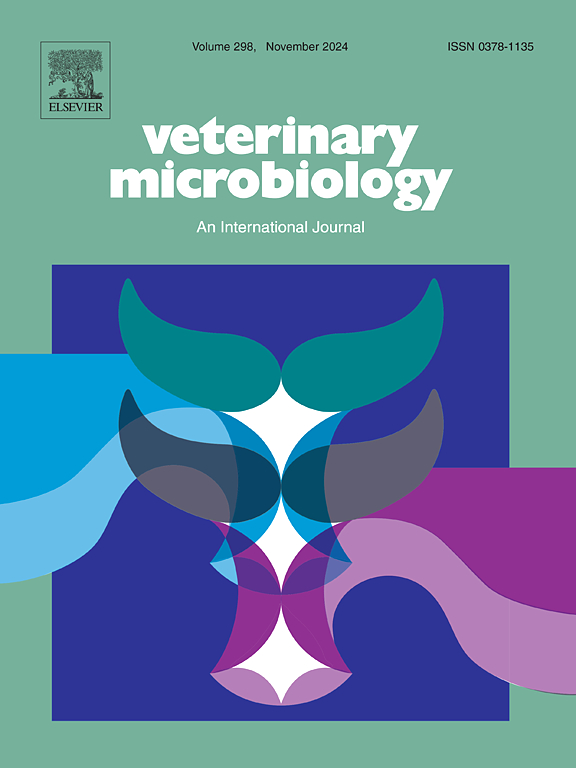Emergence of carbapenem resistant Escherichia coli, Morganella morganii, Providencia rettgeri harboring blaNDM genes in minks from China
IF 2.4
2区 农林科学
Q3 MICROBIOLOGY
引用次数: 0
Abstract
Although carbapenems have not been approved for animal use, carbapenem-resistant Enterobacteriaceae (CRE) strains are increasingly being detected in animals, posing a significant public health risk. However, the epidemiological characteristics of CRE isolates in animals remain elusive. We comprehensively investigated the genetic features of carbapenem-resistant Enterobacteriaceae isolates recovered from minks in Shandong province, China. A total of seven (38.8 %) NDM-positive isolates were identified including three Morganella morganii, three Providencia rettgeri, and one Escherichia coli from 18 samples comprises of mink feed, intestinal content, liver, spleen and lungs collected from four deceased minks. Among these isolates, only one carried the blaNDM-5 gene, while the remaining six harbored the blaNDM-1 gene and exhibited high levels of meropenem resistance (32–128 µg/mL). Genome sequencing confirmed that all M. morganii and P. rettgeri isolates harbored the chromosomally located blaNDM-1 gene while the E. coli isolate belonging to ST602 harbored the blaNDM-5 gene on ∼88 kb IncFII (pHN7A8) plasmid. To extent of our findings, this is the first discovery of carbapenem resistant Enterobacteriaceae in minks specifically the E. coli ST602 mink harboring the plasmid-mediated blaNDM-5 gene. In addition to E. coli, we have also reported a novel ST214 in P. rettgeri isolates harbored blaNDM-1 gene. Moreover, CTX-M-positive E. coli ST602 was also reported in wild birds from Chile while E. coli harboring blaNDM-5 gene on IncFIA/IncFII plasmid was also reported from healthy individuals in China. So, the emergence of these antimicrobial resistance genes in minks and their close association with humans and animals is alarming. Our findings highlight the urgent need for further surveillance of bacterial resistance to last-resort antibiotics in the animal settings One Health approach.
含有blaNDM基因的耐碳青霉烯类大肠埃希菌、摩根氏摩根菌、雷特氏普罗维登氏菌在中国水貂中的出现
尽管碳青霉烯类尚未被批准用于动物,但在动物中越来越多地检测到耐碳青霉烯类肠杆菌科(CRE)菌株,构成了重大的公共卫生风险。然而,动物CRE分离株的流行病学特征仍然难以捉摸。我们全面研究了从中国山东省水貂中回收的耐碳青霉烯肠杆菌科分离株的遗传特征。从4只死亡水貂的饲料、肠道内容物、肝脏、脾脏和肺部等18个样本中,共鉴定出7株ndm阳性分离株(38.8 %),包括3株莫氏摩根菌、3株雷氏普罗维登氏菌和1株大肠杆菌。在这些分离株中,只有1株携带blaNDM-5基因,其余6株携带blaNDM-1基因,并表现出高水平的美罗培南耐药性(32-128 µg/mL)。基因组测序证实,所有morganii和P. rettgeri分离株都携带染色体定位的blaNDM-1基因,而属于ST602的大肠杆菌分离株在~ 88 kb的IncFII (pHN7A8)质粒上携带blaNDM-5基因。就我们的研究结果而言,这是首次在水貂中发现耐碳青霉烯类肠杆菌科细菌,特别是携带质粒介导的blaNDM-5基因的大肠杆菌ST602水貂。除大肠杆菌外,我们还报道了一株含有blaNDM-1基因的雷氏杆菌ST214。此外,在智利的野生鸟类中也报道了ctx - m阳性的大肠杆菌ST602,在中国的健康个体中也报道了在IncFIA/IncFII质粒上携带blaNDM-5基因的大肠杆菌。因此,水貂中出现的这些抗微生物基因及其与人类和动物的密切联系令人担忧。我们的研究结果强调,迫切需要进一步监测动物环境中细菌对最后手段抗生素的耐药性。
本文章由计算机程序翻译,如有差异,请以英文原文为准。
求助全文
约1分钟内获得全文
求助全文
来源期刊

Veterinary microbiology
农林科学-兽医学
CiteScore
5.90
自引率
6.10%
发文量
221
审稿时长
52 days
期刊介绍:
Veterinary Microbiology is concerned with microbial (bacterial, fungal, viral) diseases of domesticated vertebrate animals (livestock, companion animals, fur-bearing animals, game, poultry, fish) that supply food, other useful products or companionship. In addition, Microbial diseases of wild animals living in captivity, or as members of the feral fauna will also be considered if the infections are of interest because of their interrelation with humans (zoonoses) and/or domestic animals. Studies of antimicrobial resistance are also included, provided that the results represent a substantial advance in knowledge. Authors are strongly encouraged to read - prior to submission - the Editorials (''Scope or cope'' and ''Scope or cope II'') published previously in the journal. The Editors reserve the right to suggest submission to another journal for those papers which they feel would be more appropriate for consideration by that journal.
Original research papers of high quality and novelty on aspects of control, host response, molecular biology, pathogenesis, prevention, and treatment of microbial diseases of animals are published. Papers dealing primarily with immunology, epidemiology, molecular biology and antiviral or microbial agents will only be considered if they demonstrate a clear impact on a disease. Papers focusing solely on diagnostic techniques (such as another PCR protocol or ELISA) will not be published - focus should be on a microorganism and not on a particular technique. Papers only reporting microbial sequences, transcriptomics data, or proteomics data will not be considered unless the results represent a substantial advance in knowledge.
Drug trial papers will be considered if they have general application or significance. Papers on the identification of microorganisms will also be considered, but detailed taxonomic studies do not fall within the scope of the journal. Case reports will not be published, unless they have general application or contain novel aspects. Papers of geographically limited interest, which repeat what had been established elsewhere will not be considered. The readership of the journal is global.
 求助内容:
求助内容: 应助结果提醒方式:
应助结果提醒方式:


